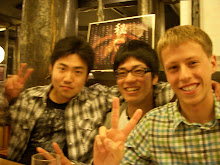
On Friday, 11 March 2011 at approximately 14:46 Japan Standard Time, a magnitude 9.0Mw megathrust earthquake rocked the Northeast prefectures of Honshu (本州), the main island of Japan. Shortly thereafter, a large tsunami (津波) exceeding 10 meters in height crashed ashore along Japan's northeastern coast. Coastal sections of Sendai-shi (仙台市), a city in Miyagi Prefecture (宮城県) with a population exceeding 1 million, and surrounding areas, were completely devastated by the earthquake and inundated by ensuing tsunami. As it stands now, over 2,400 people have been confirmed dead in the main area of destruction, with numbers likely to exceed 10,000 at final count.
The images of fallen buildings and cars, boats, and other large objects being tossed about like toys are heartbreaking. After living in Japan for several months, the task of processing the extent of the devastation each day is surreal and taxing. Japan is the world's most prepared country for large earthquakes and destructive tsunamis. Advanced technology and strict building codes protect its citizens from these unpredictable disasters caused by our unforgiving, dynamic planet. The scenes of devastation flooding the visual airwaves these past few days have stirred fear worldwide in areas prone to large earthquakes.
The Pacific Northwest of the United States and adjacent southwest Canada are susceptible to earthquakes identical to the one that struck Japan on Friday. The aforementioned geographical region lies adjacent to a subduction zone; that is, a location where one tectonic plate is forced under another into Earth's mantle. The Cascadia subduction zone is a region where the Juan de Fuca plate is subducting under the North American plate at approximately 40 mm per year. This subduction zone threatens cities like Seattle, Portland, and Vancouver, British Columbia, with earthquakes that can reach and exceed 9.0, as well as tsunamis comparable to the one witnessed in Japan. To the south of this region lies the San Andreas fault, a right-lateral strike-slip fault zone. While earthquakes are common in this region, is it not likely for a magnitude 9.0 earthquake to occur in association with its movement.
The issue across the Pacific Northwest is that, compared to Japan, it is highly unprepared for a destructive earthquake. Many old, unreinforced masonry buildings exist in abundance in major urban centers. They would collapse under the stresses imposed by a significant earthquake. Roadways and bridges would also likely crumble and fall. The Alaskan Way, of portion of which is a major viaduct in Seattle, Washington, would likely pancake in a large earthquake, flattening hundreds, if not thousands, of cars on its lower level. Large skyscrapers would likely sway back and forth, but remain upright. Low-lying areas near large bodies of water, like residential areas adjacent to the Puget Sound near Seattle and the Straight of Georgia near Vancouver, to name a couple, would likely be inundated by fast-flowing water. The scene over the past few days in Japan would likely be magnified with the occurrence of a similar event across the Pacific Northwest.
Please keep this in mind as you continue about your daily lives. Earthquakes of this magnitude occur on average once a year worldwide, but this does not mean that it cannot occur again within a 365 day time period, nor does it mean that it will occur again in the next couple of years. A consequence of living on a dynamic planet is that disasters like these do happen, and the best we can do is prepare and educated ourselves.
In the aftermath of this disaster, the generosity of humankind has once again proven outstanding. Search and rescue/recovery teams have assembled from at least fifty nations to aid in the relief efforts in Japan. The spirit of Japan has also stood salient in the face of tragedy. Strangers are helping one another by providing food, water, and other essentials to those living in the hardest-hit areas. Surprisingly (though I can understand this), looting and violence have been at a minimum, or perhaps non-existent. This is how I remember Japan - a nation that thrives off of kindness, honesty, and peace. Its remarkable that this remains true following a magnitude 9.0 earthquake and significant tsunami. This is a lesson to take home.
Please keep the people of Japan in your thoughts and prayers this week and beyond as they continue to rebuild their lives. Donations can be made to legitimate agencies, like the American Red Cross or the Japanese Red Cross via Google.com, among others.
Finally, as you prepare to sleep this evening, think of the people that have been affected by this tragedy, and remember how fortunate you are.
がんばれ東北、がんばれ日本。私たちはために祈る。Ganbare Touhoku, Ganbare Nihon. Watashitachi wa tame ni inoru. Hang in there Northeast, hang in there Japan. We are praying for you.


1 comment:
Very well said Larry.
Post a Comment